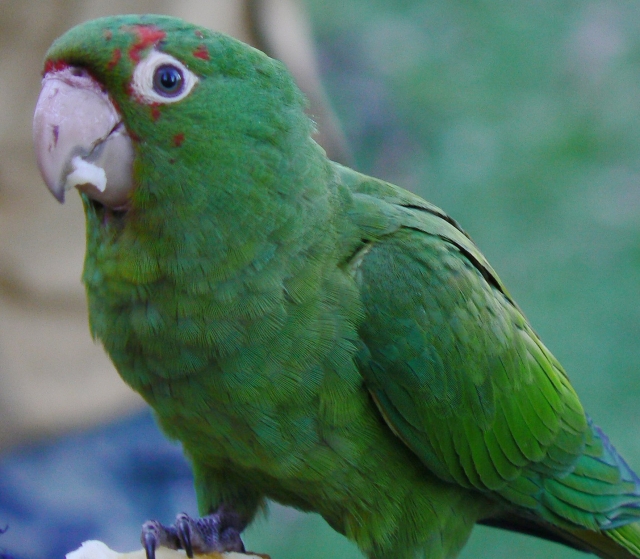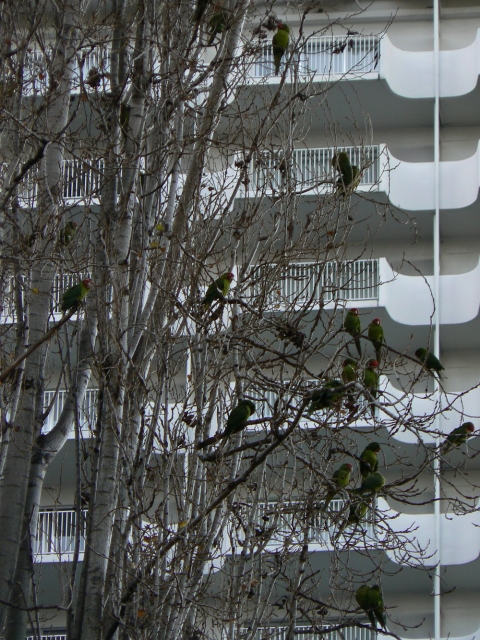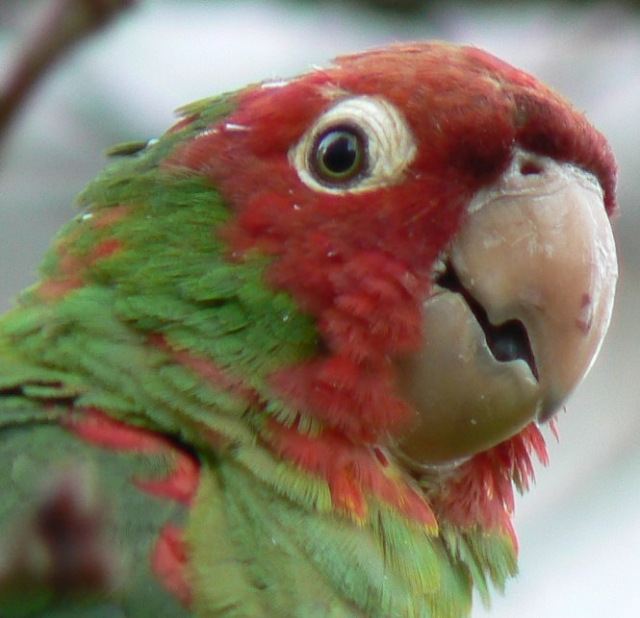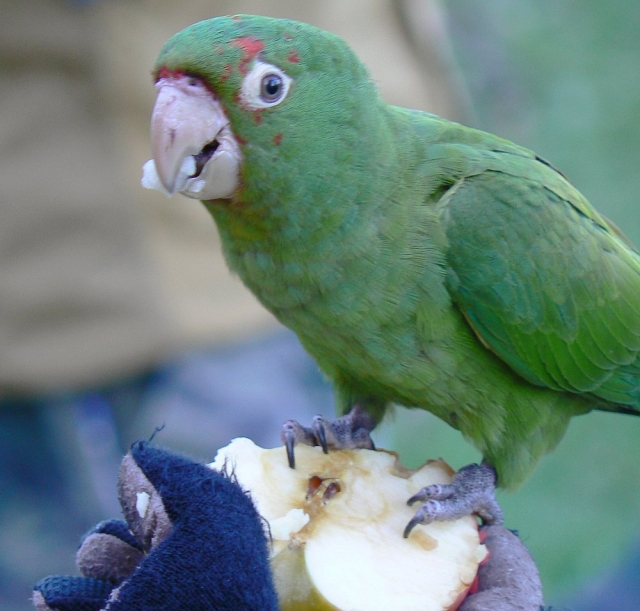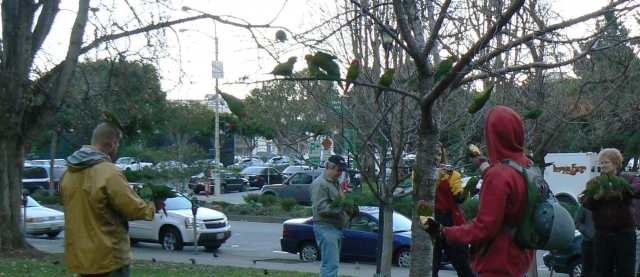From the Open-Publishing Calendar
From the Open-Publishing Newswire
Indybay Feature
Parrots Withstand Cold Weather In San Francisco's Financial District.
As everyone faces the problems of cold weather, I was surprised to see a flock of parrots near the anti-recruitment demo I want to today in San Francisco. They apparently have survived at leat one past freeze, so hopefully they can make it through the next couple of days of record cold. I was at the anti-war protest and heard a flock of some loud bird flying overhead and figured they might be the parrots I had heard about so when I was walking back to BART and heard a loud sound from a nearby park, I walked over and found a few people feeding the birds apples, while hundreds of other birds were just sitting in the trees above the park. Apparently this is the same flock that was up on Telegraph Hill and had a movie made about them.
Although I just heard them squawking, apparently the type of parrot in SF is one that can talk and is quite intelligent (some other species of parrots can have a human "vocabulary of 950 words, and shows signs of a sense of humour").
Although I just heard them squawking, apparently the type of parrot in SF is one that can talk and is quite intelligent (some other species of parrots can have a human "vocabulary of 950 words, and shows signs of a sense of humour").
---
Here are some related things I found when I got home
----
Most of the birds in the flock are the same species, a parrot known variously as the cherry-headed conure, the red-masked conure, the red-masked parakeet, and the red-headed conure....Its scientific name is Aratinga erythrogenys.
There is also a female mitred conure, or parakeet, in the flock. (This photo was taken when she was in my care during an illness.) Its scientific name is Aratinga mitrata. She has been breeding with the cherry heads, so there are a lot of hybrids in the flock. The hybrids are fertile, too.
There are two flocks of parrots in San Francisco. The flock that roosts along Dolores Street and flies to Potrero Hill and Noe Valley is a different species: the canary-winged parakeet (Brotegeris versicolorus). The canary wings have been in San Francisco since the early 1970s.
-----
The Red-masked parakeet, Aratinga erythrogenys, is a medium-sized South American parrot from Ecuador and Peru. It is known in the pet trade as the Cherry-headed Conure. It has been the 10th most common neotropical parrot imported into the USA with over 26,000 parakeets checked in from 1981-1985. This bird was formerly more common in its limited range, and only fairly recently has been reclassified from a species of least concern to a species near threatened (1994).
Red-masked parakeets average about 33 cm (13 in) long, of which half is the tail. They are bright green with a mostly red head on which the elongated pale eye-ring is conspicuous; the nape is green. Also, the lesser and median underwing coverts are red, and there is some red on the neck, the thighs, and the leading edge of the wings.
Clutches average 3 to 4 eggs and incubation is 23 or 24 days. Nests are usually made in tree cavities. Juvenile birds fledge after 50 days with solid green plumage; their first red feathers appear around the age of 4 months. The call is two-syllabled, harsh and loud.
These birds are native to southwestern Ecuador and northwestern Peru, where they inhabit forest edges and partially cleared areas. Some are sold as cage birds; they are considered good talkers. Escaped cage birds are considered to be introduced in Spain. They are also found in Florida and California, and make up most of the feral population in San Francisco that was documented in the book The Wild Parrots of Telegraph Hill by Mark Bittner and the film of the same name by Judy Irving. Although these birds reproduce in the wild, the Red-masked Parakeet is not considered established in North America.
Breeding popultations of feral parakeets have been observed in San Diego County, Los Angeles, San Gabriel Valley, Sunnyvale and San Francisco. The birds have been observed feeding on the fruits of the cultivated tropical vegetation, and nesting in the ubiquitous palm trees.
http://en.wikipedia.org/wiki/Red-masked_Parakeet
-----
Establishing a population in Los Angeles of significant numbers of escaped pets, the Mitred Conure of South America is transplanting itself with accidental human help! In fact a wild flock was even reported to be thriving in Brooklyn, New York in spite of the freezing temperatures.
....
Originating in Peru, Mitred Conures are also found in northwestern Argentina and eastern Bolivia. They were first noted by Tschudi in 1844. Today, Mitred Conures are very popular as pets. They are studied closely in the United States because escaped pets have formed a flock of about 40 birds that live in Los Angeles and they function much as wild South American Conures will. It is speculated that they may start an American population.
http://www.centralpets.com/animals/birds/parrots/prt1284.html
Here are some related things I found when I got home
----
Most of the birds in the flock are the same species, a parrot known variously as the cherry-headed conure, the red-masked conure, the red-masked parakeet, and the red-headed conure....Its scientific name is Aratinga erythrogenys.
There is also a female mitred conure, or parakeet, in the flock. (This photo was taken when she was in my care during an illness.) Its scientific name is Aratinga mitrata. She has been breeding with the cherry heads, so there are a lot of hybrids in the flock. The hybrids are fertile, too.
There are two flocks of parrots in San Francisco. The flock that roosts along Dolores Street and flies to Potrero Hill and Noe Valley is a different species: the canary-winged parakeet (Brotegeris versicolorus). The canary wings have been in San Francisco since the early 1970s.
-----
The Red-masked parakeet, Aratinga erythrogenys, is a medium-sized South American parrot from Ecuador and Peru. It is known in the pet trade as the Cherry-headed Conure. It has been the 10th most common neotropical parrot imported into the USA with over 26,000 parakeets checked in from 1981-1985. This bird was formerly more common in its limited range, and only fairly recently has been reclassified from a species of least concern to a species near threatened (1994).
Red-masked parakeets average about 33 cm (13 in) long, of which half is the tail. They are bright green with a mostly red head on which the elongated pale eye-ring is conspicuous; the nape is green. Also, the lesser and median underwing coverts are red, and there is some red on the neck, the thighs, and the leading edge of the wings.
Clutches average 3 to 4 eggs and incubation is 23 or 24 days. Nests are usually made in tree cavities. Juvenile birds fledge after 50 days with solid green plumage; their first red feathers appear around the age of 4 months. The call is two-syllabled, harsh and loud.
These birds are native to southwestern Ecuador and northwestern Peru, where they inhabit forest edges and partially cleared areas. Some are sold as cage birds; they are considered good talkers. Escaped cage birds are considered to be introduced in Spain. They are also found in Florida and California, and make up most of the feral population in San Francisco that was documented in the book The Wild Parrots of Telegraph Hill by Mark Bittner and the film of the same name by Judy Irving. Although these birds reproduce in the wild, the Red-masked Parakeet is not considered established in North America.
Breeding popultations of feral parakeets have been observed in San Diego County, Los Angeles, San Gabriel Valley, Sunnyvale and San Francisco. The birds have been observed feeding on the fruits of the cultivated tropical vegetation, and nesting in the ubiquitous palm trees.
http://en.wikipedia.org/wiki/Red-masked_Parakeet
-----
Establishing a population in Los Angeles of significant numbers of escaped pets, the Mitred Conure of South America is transplanting itself with accidental human help! In fact a wild flock was even reported to be thriving in Brooklyn, New York in spite of the freezing temperatures.
....
Originating in Peru, Mitred Conures are also found in northwestern Argentina and eastern Bolivia. They were first noted by Tschudi in 1844. Today, Mitred Conures are very popular as pets. They are studied closely in the United States because escaped pets have formed a flock of about 40 birds that live in Los Angeles and they function much as wild South American Conures will. It is speculated that they may start an American population.
http://www.centralpets.com/animals/birds/parrots/prt1284.html
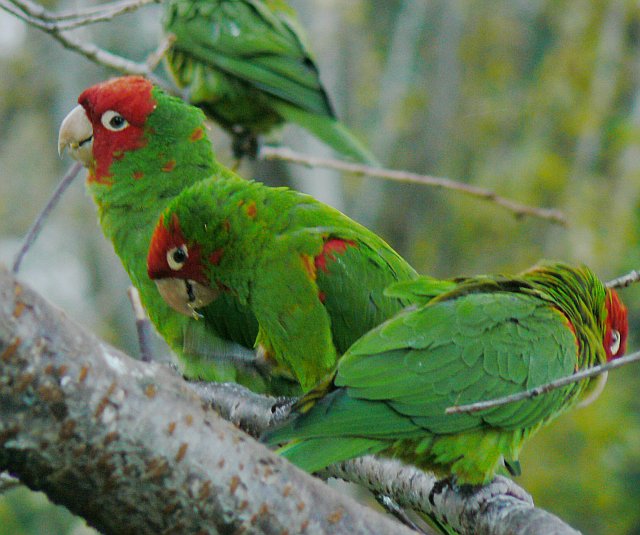
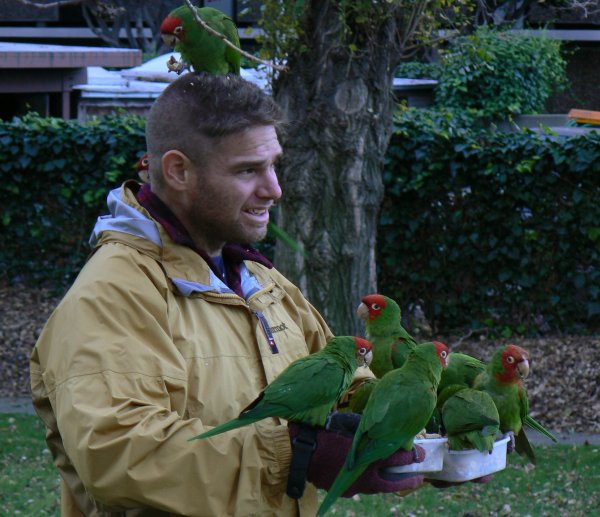

Add Your Comments
Comments
(Hide Comments)
Nice post "z" ... great photos and nice to hear someone bringing them up ... I'm pulling for the parrots now, hoping they make it through the cold ...
Hi!
An amazing man named Mark Bittner fed these cherry headed conures for 5 years. Judy Irving made a film about it. It is the most wonderful movie I have ever seen. It's right up there with March of the Penguins.
Here is some info about it. It was a runaway hit in SF.
http://www.markbittner.net/film.html
This is the book:
http://www.markbittner.net/parrots_book/index.html
and here are some photos Mark took of the parrots over 5 years.
http://www.lindafairchild.com/specs.php?id=26&gal=9&pos=1
I really really urge you to see the movie. I was so deeply moved by it.
Best,
Barbara
owned by Harry, red-lored Amazon
An amazing man named Mark Bittner fed these cherry headed conures for 5 years. Judy Irving made a film about it. It is the most wonderful movie I have ever seen. It's right up there with March of the Penguins.
Here is some info about it. It was a runaway hit in SF.
http://www.markbittner.net/film.html
This is the book:
http://www.markbittner.net/parrots_book/index.html
and here are some photos Mark took of the parrots over 5 years.
http://www.lindafairchild.com/specs.php?id=26&gal=9&pos=1
I really really urge you to see the movie. I was so deeply moved by it.
Best,
Barbara
owned by Harry, red-lored Amazon
For more information:
http://www.barbarasdreams.com
It's been a case of pretty polly up to now, but it may not be for much longer. Government scientists are to investigate the activities of the flocks of rose-ringed parakeets breeding in London's suburbs, amid rising fears that they may be harming native British bird species.
The brilliant green parakeets have hitherto been a popular sight in the parks and gardens where they are to be found, squabbling and dashing from tree to tree, in a broad swath of south London from Croydon in the east to Esher and beyond in the west. But since they first began breeding in the wild more than 40 years ago, their numbers have built up to a point where now some ecologists fear their population is exploding, with potentially damaging results. It is feared that the parakeets, which nest in holes and crevices in trees, may be displacing British tree-nesting species such as woodpeckers, nuthatches and starlings.
There is as yet no hard evidence that this is taking place, says the Royal Society for the Protection of Birds (RSPB). But as a precaution the society has asked the Government to investigate the risk from the parakeets under its recently launched strategy for dealing with invasive non-native species.
The strategy is focusing on troublesome plants such as the rapidly-spreading Japanese knotweed, whose eradication from the Olympics site in east London alone may cost millions of pounds, and invertebrates such as the Chinese mitten crab, which is doing much damage burrowing under the banks of the Thames and other rivers.
The rose-ringed parakeet,Psittacula krameri, which is native to a great belt of land stretching from Africa across to India and the Himalayas, is the most obvious bird which in Britain today could be seen as invasive and non-native.
No one knows how it came to start breeding in London, although it is certain to have been the result of the accidental or deliberate release of captive birds. One persistent theory is that an entire flock escaped from Shepperton Studios in Surrey in 1951, during the filming of the adventure drama The African Queen, starring Humphrey Bogart and Katherine Hepburn.
They are now particulary plentiful in west London, especially in the wooded stretch of the Thames from Kew to Hampton Court; they have become a permanent feature, for example, at the Royal Botanic Gardens, where their sharply-loud screeching call and long flight silhouette are as distinctive as their brilliant emerald plumage.
The ecologist Tony Drakeford thinks their population must be in excess of 30,000, and rapidly expanding. He is convinced they must be displacing native birds. "Recently I went to Bushy Park where there thousands of parakeets and very few native birds," he said. But he thinks it may be too late to do anything about it. "A major cull would meet with a lot of opposition," he said.
News reports of the Government inquiry, to be carried out by the Central Science Laboratory, have prompted local paper headlines that a cull is imminent, backed by the RSPB. But an RSPB spokesman, Andre Farrar, denied the society was backing any mass killing. "We have simply asked the Government to study the situation," he said. "Some people think they are doing harm, but as yet there is no hard evidence that they are."
If it were proved that the parakeets were causing a reduction in the conservation status of native British bird species, "then a cull might be the right answer", Mr Farrar said - pointing out that of the 1,200 globally-threatened species of birds, 340 were threatened by introduced non-native species.
But, he said, at the moment the RSPB was not calling for any cull, merely for an inquiry.
http://news.independent.co.uk/environment/wildlife/article2381071.ece
The brilliant green parakeets have hitherto been a popular sight in the parks and gardens where they are to be found, squabbling and dashing from tree to tree, in a broad swath of south London from Croydon in the east to Esher and beyond in the west. But since they first began breeding in the wild more than 40 years ago, their numbers have built up to a point where now some ecologists fear their population is exploding, with potentially damaging results. It is feared that the parakeets, which nest in holes and crevices in trees, may be displacing British tree-nesting species such as woodpeckers, nuthatches and starlings.
There is as yet no hard evidence that this is taking place, says the Royal Society for the Protection of Birds (RSPB). But as a precaution the society has asked the Government to investigate the risk from the parakeets under its recently launched strategy for dealing with invasive non-native species.
The strategy is focusing on troublesome plants such as the rapidly-spreading Japanese knotweed, whose eradication from the Olympics site in east London alone may cost millions of pounds, and invertebrates such as the Chinese mitten crab, which is doing much damage burrowing under the banks of the Thames and other rivers.
The rose-ringed parakeet,Psittacula krameri, which is native to a great belt of land stretching from Africa across to India and the Himalayas, is the most obvious bird which in Britain today could be seen as invasive and non-native.
No one knows how it came to start breeding in London, although it is certain to have been the result of the accidental or deliberate release of captive birds. One persistent theory is that an entire flock escaped from Shepperton Studios in Surrey in 1951, during the filming of the adventure drama The African Queen, starring Humphrey Bogart and Katherine Hepburn.
They are now particulary plentiful in west London, especially in the wooded stretch of the Thames from Kew to Hampton Court; they have become a permanent feature, for example, at the Royal Botanic Gardens, where their sharply-loud screeching call and long flight silhouette are as distinctive as their brilliant emerald plumage.
The ecologist Tony Drakeford thinks their population must be in excess of 30,000, and rapidly expanding. He is convinced they must be displacing native birds. "Recently I went to Bushy Park where there thousands of parakeets and very few native birds," he said. But he thinks it may be too late to do anything about it. "A major cull would meet with a lot of opposition," he said.
News reports of the Government inquiry, to be carried out by the Central Science Laboratory, have prompted local paper headlines that a cull is imminent, backed by the RSPB. But an RSPB spokesman, Andre Farrar, denied the society was backing any mass killing. "We have simply asked the Government to study the situation," he said. "Some people think they are doing harm, but as yet there is no hard evidence that they are."
If it were proved that the parakeets were causing a reduction in the conservation status of native British bird species, "then a cull might be the right answer", Mr Farrar said - pointing out that of the 1,200 globally-threatened species of birds, 340 were threatened by introduced non-native species.
But, he said, at the moment the RSPB was not calling for any cull, merely for an inquiry.
http://news.independent.co.uk/environment/wildlife/article2381071.ece
the SF supervisors are set to vote on a law that would ban feeding these parrots for a variety of reasons
For more information:
http://www.indybay.org/newsitems/2007/05/2...
We are 100% volunteer and depend on your participation to sustain our efforts!
Get Involved
If you'd like to help with maintaining or developing the website, contact us.
Publish
Publish your stories and upcoming events on Indybay.
Topics
More
Search Indybay's Archives
Advanced Search
►
▼
IMC Network


